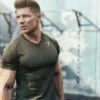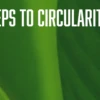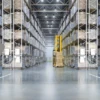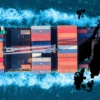We’re excited to share our latest Beyond Threads podcast, featuring Kevin Paindeville, Director of Warehouse Solutions and Innovation at Bleckmann, and Eric Ebbers, Senior Sales Manager at Kardex. Read on to discover the key takeaways from their discussion, which focused on how automation can empower businesses to grow and deliver a superior customer experience. Check out the podcast for even more expert insights!
Why automation is crucial for logistics
Whether it’s helping to improve order accuracy, reducing costs, or scaling operations, automation is an increasing necessity in today’s fast-paced fashion logistics industry. “When I meet with customers in the fashion industry, scalability and flexibility are essential for them, due to the fast-changing nature of the business”, Eric shared. “Any automation solution therefore needs to be easily scalable to the brand’s logistics needs.”
One example of this approach is AutoStore, a cube storage system that Bleckmann uses to automate the storage and retrieval of goods. AutoStore’s modular design allows companies to easily scale by adding or removing components as needed. Another advantage is its storage density: more units can be stored per square metre compared to traditional setups, further increasing efficiency and flexibility. And it’s a goods-to-person system, reducing the time that operators spend walking around the warehouse.
Listen To Audio Only
Making automation accessible to more brands
A common concern with automation is the cost. However, the return over time can be significant. There are also solutions to reduce the upfront investment cost. “To provide the benefits of automation to smaller brands”, Kevin explained, “Bleckmann implemented a flexible solution where several smaller brands use the same AutoStore”.
There are also many benefits from an ease-of-use perspective. For example, the system offers a pick-to-light feature with a laser pointer and an intuitive assistant that turns the operator’s desk into an interactive screen. If the wrong tote is picked for a particular order, the desk turns red; if it’s correct, it stays green. As Kevin put it, “The assistant makes it very difficult to make a mistake!” And the development of automation in the logistics industry is just getting started. Check out the podcast for even more expert insights!
Ready to take the next step in your innovation journey? Press play to hear the full story!
__________________________________________________________________________________________________________________
Transcript
Erik Janssen Steenberg: Hi there, and welcome to the Beyond Threads Podcast by Bleckmann. My name is Erik Janssen Steenberg, I'm your host for today. Thank you very much for joining us. In each episode, we take a deep dive into technology, into innovation and everything that it takes to stay relevant in the sector of Supply Chain Logistics and Fulfilment. And today we are particularly excited, because we're going to talk about innovation. Where we, in other podcasts may take a deep dive into software, into the people behind the processes we're now going to look at the actual innovation. I'm joined today by Kevin Paindeville Bleckmann's very own Director of Innovations and Warehouse Solutions.
Kevin Paindeville: Thanks, Erik. Nice to be here.
Erik Janssen Steenberg: And a very special guest, Eric Ebbers, Senior Sales Manager at Kardex.
Eric Ebbers: Yes, hello. Thank you for the invite. Thrilled to be here at Bleckmann.
Erik Janssen Steenberg: Kevin, today we will be covering the topic of innovation in logistics. Specifically automation. Can you explain to the audience and me what it really means? Automation in logistics or logistics automation. And maybe give us a brief introduction of yourself.
Kevin Paindeville: Sure, as you mentioned, my name is Kevin. Working for Bleckmann since 4 years now. Responsible for Innovation and Warehouse Solutions and Design.
When you look at automation, to make it very simple we are speaking about machines able to replace manual work. If you're looking within the four walls of the warehouse it can go from moving products from A to B on pallets or something else. It can be the picking, it can be the packing, adjusting the carton to the content of the order. There are various ways to speak about automation within warehouses.
Erik Janssen Steenberg: Yes, and we are excited to have representation of Kardex in today's podcast as well.
Eric, can you please introduce yourself and give a brief overview of what AutoStore means for a company like Bleckmann?
Eric Ebbers: Yes, of course. My name is Eric Ebbers. I am Senior Sales Manager at Kardex. Enabling customers' growth by finding the best automated logistics systems solution in order to help them with their business. I have a lifetime experience in intralogistics. Intralogistics is a word for all the flows, material flows, information flows under one roof as Kevin already said: within the four walls. And I have more than 25 years of experience, started with the material handling equipment and later on, shifted to goods-to-person systems, what we can also see at Bleckmann.
AutoStore belongs to the goods-to-person systems. It is a so-called cube storage system an ASRS, Automatic Storage and Retrieval System. And maybe it's good to first explain what AutoStore is because I noticed that some people say AutoStore is a store where you can buy cars. That's not the thing. AutoStore is a storage grid where there are a lot of stacks with totes.
Erik Janssen Steenberg: A tote being a large bucket or container?
Eric Ebbers: Yes, a large container. And on top of this grid, there are robot transporting the totes to the pick stations where the operator is standing and pulls out the correct SKU.
Erik Janssen Steenberg: So, that means the product is brought to the person processing the order and they don't have to go into the warehouse to retrieve the product?
Eric Ebbers: Exactly.
Erik Janssen Steenberg: Okay.
Kevin Paindeville: That's key to walking distance.
Eric Ebbers: Yes, I think that's the main advantage. And that's also the shift that we see in companies changing from a manual operation to an automatic operation. That the operator does not need to walk for kilometres on a daily basis. The goods are brought to the person, to the operator which saves time.
Erik Janssen Steenberg: Absolutely. And can you guys explain to me why automation has taken such a huge flight and has become a critical component of logistics?
Kevin Paindeville: Well, you have a couple of elements in play. You have, first, the shortage of labour on the market. It's more and more difficult to find people. Especially if you grow and you need to cope with a much larger volume. And you need a lot of people, it's not that easy in some regions where we are located. And so, automation plays a role, because you will automate and free up capacity. Because the people doing the task that will be automated by the machine, by the AutoStore. could be allocated to tasks that bring more added value when done by a human.
Erik Janssen Steenberg: Yes, okay. That makes sense.
Eric Ebbers: And I think, especially 3PLs (third party logistics providers), they are really interested in flexible systems, which are scalable. Because you never know what happens tomorrow. And you want to adapt your system to the new business demands.
Erik Janssen Steenberg: Yes, especially at a company like Bleckmann, fashion and lifestyle logistics . Very seasonal, high peaks.Okay, understood.
And Eric, when we look at AutoStore, when we look at Kardex what are the specific systems and technologies that you offer companies like us? And how do you set yourself apart from your competitors?
Eric Ebbers: AutoStore is a goods-to-person system which has grown very rapidly. Now, there are already 1400 installations sold worldwide. As mentioned before, it's very flexible, scalable. The system consists of a couple of components that you can put together. I always say it's like playing with Lego, you're never done. You can always change the system by adding things to the AutoStore, for example. That's also what Bleckmann has done. Started last year with only a small AutoStore to start with 24,000 totes, 24 robots, a couple of pick ports. But they have grown so huge that now we have already extended the AutoStore to 100,000 totes and 70 robots during operation. So, that is, I think, a very important point for a customer, that there is no end of the line. That they can always continue growing and not invest money in tomorrow, but in today.
Kevin Paindeville: To add to that, sorry to interrupt you, Erik, but to add to that two more differentiators of AutoStore: Scalability. We start small and you increase. We can increase as much as we want. Second, the storage density of the system is one of the highest on the market. So, on a square metre you can store a lot of units compared to manual or other types of automation.
Erik Janssen Steenberg: I have been to the set-up in Grobbendonk, Belgium. And not only for a customer it's obvious that you're never done it's scalable, you're flexible but also as a BD Manager, I love to show that to customers. Because it's clear to anybody who sees it, that it's smart, efficient and flexible. So, regardless of the specific needs of my customer, I can always show them the AutoStore. So, that's where, for me, the added value comes from.
Eric Ebbers: Absolutely. When you compare it to a conventional warehouse you take out all the air that is in the aisles because you put the totes in the grid, in stacks. So, you are able to quadruple the space of your warehouse. And that's fantastic.
Erik Janssen Steenberg: In the same area?
Eric Ebbers: In the same area, yes.
Erik Janssen Steenberg: So, that says a lot about how your automation, how your solution increases the operational capacity. But how does it also influence, better the accuracy in the operation?
Eric Ebbers: The robots are bringing the tote to the operator. So, we already have the correct tote in front of the operator. If this tote consists of more than one storage location then you can see on your screen from which compartment you need to pick how many items. You can also have a put-to-light system, or a pick-to-light system with a laser pointer. And also a very nice innovation from Kardex is the Intuitive “Picking Assistant”. That's an innovation which projects all the information on your workstation, on your desk. So, through this projection, your desk turns into a huge iPad which you can tap to confirm all the instructions. So, like when driving a car and you see the projection in your heads-up display you see it around the SKUs that you need to pick. And if you go with your hand into the wrong compartment, then your whole desk turns red. And if you do it right, then everything is green. So, that's also something that is very interesting, to have a clean desk. You don't need a terminal, keyboard, mouse, even a scanner is not necessary anymore because the Intuitive Picking Assistant can automatically scan the SKU that you take out.
Erik Janssen Steenberg: So, that sounds to be, as my American friends would say, full-proof and fool-proof. Makes it very hard to make a mistake.
Kevin Paindeville: Absolutely.
Erik Janssen Steenberg: That sounds very good. Kevin, we also have a lot of smaller and medium-sized customers. Automation sounds rather expensive. Is that indeed the case for our customers? Or is it much more an opportunity to have it as a good entry point?
Kevin Paindeville: Automation is expensive, that's true. It costs money. But that doesn't mean there is no payback. What we did at Bleckmann's, we built a pre-automated warehouse. The AutoStore was there before we had the first customer to put in it. And then we combined different customers in it so that we can guarantee that we have sufficient efficiency. And every customer, at least every customer that fits within the boundaries of the business case can fit into the AutoStore. So, we didn't build one solution for a customer that exists we have a customer where we can afford that or some of the customers. Also taking into account the contract length within the 3PL world it's important we have a solution that is flexible. And if, for certain reasons a customer leaves, we are able to replace it by another one.
Erik Janssen Steenberg: Right. Now, let's try and have a sneak peek over the horizon: What do you guys think the developments will be? What do you expect in trends or in new capabilities?
Kevin Paindeville: Well, we start with the AutoStore, of course, it's not only the AutoStore. Kardex provided a solution where we also have got the picking machine, we have the full monty, I would say. It can come with things on top it can come with cobots on the pick stations doing the picking. Because when we present a tote, either one tote with one SKU or with dividers we can also guide the cobot to pick the right item and to put it in the right carton for the order. So, that could be one extra enhancement.
Erik Janssen Steenberg: And of course, just for me, because our audience is more than intelligent but what's the difference between a cobot and a robot?
Kevin Paindeville: A robot is what you will see in a big factory. It's very efficient and you see it on a manufacturing lane. It's very precise, very rapid, but you have a lot of fencing around it, or a lot of safety. Because if you come closer, you get hit and it hurts. Not to say anything else. A cobot is a collaborative robot. Meaning that the speed is not as high as on a real robot. They also have some safety around with sensors but it will slow down if you approach it. So, you need to let it work to enjoy the full speed of the cobot. But if you need to go nearby, it will slow down, until the moment you touch it and then it stops. Because it doesn't want to hurt you. So, collaborative robot means it's a robot but it can be put in the same area as other humans.
Erik Janssen Steenberg: And a robot is autonomous, disregarding everything around it.
Executioner of repetitive tasks.
Kevin Paindeville: A robot in manufacturing is not autonomous because it's commanded by a system, but it's always doing the same task. Here, we are speaking about cobots with vision technology because it needs to know where it needs to pick, why it needs to pick how it needs to position its gripper, and all that stuff. So, it's a combination of elements.
Erik Janssen Steenberg: Thanks for explaining that.
Eric Ebbers: And in that case, the people can be reallocated in the warehouse for more human-added value, which I think is very important. And looking at the costs, there was also a question about automation and costs. This is, in my experience, often the second step for a company so that they can make a new business case. First, it's the automation, the beating heart, the AutoStore and everything around it. And then the next step could be a cobot or could be an AMR instead of a conveyor system because a 3PL always wants to have full flexibility. And a conveyor system always goes from A to B but an AMR can drive through the whole warehouse to a new location.
Erik Janssen Steenberg: And an AMR is another 3-letter abbreviation and that stands for?
Eric Ebbers: Autonomous Mobile Robot.
Erik Janssen Steenberg: Gentlemen, thank you very much for your insights. I think a very interesting conversation. And good to have your input, your outlook for the future. And who knows, hopefully we'll see each other soon at this very table. But before we conclude, Eric: If our audience has any questions about Kardex, AutoStore and all the services and solutions that you offer, how can they reach out to you?
Eric Ebbers: That's very easy. You can go to kardex.com or find me on LinkedIn. And I'm happy to help you.
Erik Janssen Steenberg: Thank you for that. Kevin, same question for you, of course.
Kevin Paindeville: Yes, LinkedIn, always a good way to reach out. Otherwise, people can look on the Bleckmann.com website where we also post some interesting use cases we have made.
Erik Janssen Steenberg: And as much as we would love to continue this discussion, unfortunately our time is up. I would like to thank you for joining our discussion. Again, I thought a very knowledgeable discussion and we have learned a lot. I would like to invite you to stay tuned and on the lookout for our next podcast. I'll see you there. Thank you!











